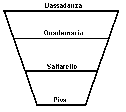Time sequences
 The
basics of understanding misure is the understanding of how the
music related to the dance. In all Italian dances there were only
four major time sequences used, these are shown on a diagram in
Cornazano’s text which looks somewhat like this:
The
basics of understanding misure is the understanding of how the
music related to the dance. In all Italian dances there were only
four major time sequences used, these are shown on a diagram in
Cornazano’s text which looks somewhat like this:
The diagram shows the relationship between the four misure, bassadanza, quadernaria, saltarello, and piva.